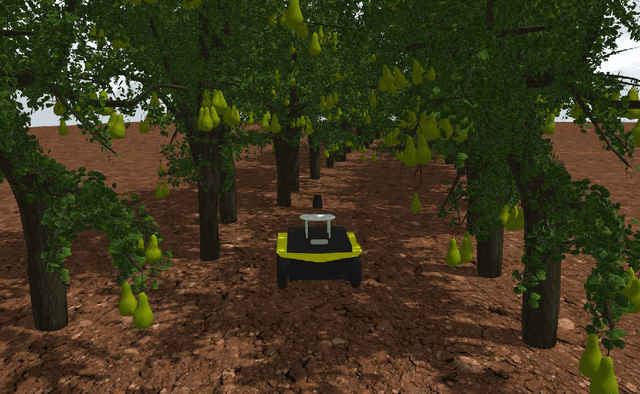Andrea Ostuni
Adaptive Social Force Window Planner with Reinforcement Learning
Apr 21, 2024Abstract:Human-aware navigation is a complex task for mobile robots, requiring an autonomous navigation system capable of achieving efficient path planning together with socially compliant behaviors. Social planners usually add costs or constraints to the objective function, leading to intricate tuning processes or tailoring the solution to the specific social scenario. Machine Learning can enhance planners' versatility and help them learn complex social behaviors from data. This work proposes an adaptive social planner, using a Deep Reinforcement Learning agent to dynamically adjust the weighting parameters of the cost function used to evaluate trajectories. The resulting planner combines the robustness of the classic Dynamic Window Approach, integrated with a social cost based on the Social Force Model, and the flexibility of learning methods to boost the overall performance on social navigation tasks. Our extensive experimentation on different environments demonstrates the general advantage of the proposed method over static cost planners.
Non-linear Model Predictive Control for Multi-task GPS-free Autonomous Navigation in Vineyards
Apr 08, 2024



Abstract:Autonomous navigation is the foundation of agricultural robots. This paper focuses on developing an advanced autonomous navigation system for a rover operating within row-based crops. A position-agnostic system is proposed to address the challenging situation when standard localization methods, like GPS, fail due to unfavorable weather or obstructed signals. This breakthrough is especially vital in densely vegetated regions, including areas covered by thick tree canopies or pergola vineyards. This work proposed a novel system that leverages a single RGB-D camera and a Non-linear Model Predictive Control strategy to navigate through entire rows, adapting to various crop spacing. The presented solution demonstrates versatility in handling diverse crop densities, environmental factors, and multiple navigation tasks to support agricultural activities at an extremely cost-effective implementation. Experimental validation in simulated and real vineyards underscores the system's robustness and competitiveness in both standard row traversal and target objects approach.
GPS-free Autonomous Navigation in Cluttered Tree Rows with Deep Semantic Segmentation
Apr 08, 2024



Abstract:Segmentation-based autonomous navigation has recently been presented as an appealing approach to guiding robotic platforms through crop rows without requiring perfect GPS localization. Nevertheless, current techniques are restricted to situations where the distinct separation between the plants and the sky allows for the identification of the row's center. However, tall, dense vegetation, such as high tree rows and orchards, is the primary cause of GPS signal blockage. In this study, we increase the overall robustness and adaptability of the control algorithm by extending the segmentation-based robotic guiding to those cases where canopies and branches occlude the sky and prevent the utilization of GPS and earlier approaches. An efficient Deep Neural Network architecture has been used to address semantic segmentation, performing the training with synthetic data only. Numerous vineyards and tree fields have undergone extensive testing in both simulation and real-world to show the solution's competitive benefits.
Enhancing Navigation Benchmarking and Perception Data Generation for Row-based Crops in Simulation
Jun 27, 2023Abstract:Service robotics is recently enhancing precision agriculture enabling many automated processes based on efficient autonomous navigation solutions. However, data generation and infield validation campaigns hinder the progress of large-scale autonomous platforms. Simulated environments and deep visual perception are spreading as successful tools to speed up the development of robust navigation with low-cost RGB-D cameras. In this context, the contribution of this work is twofold: a synthetic dataset to train deep semantic segmentation networks together with a collection of virtual scenarios for a fast evaluation of navigation algorithms. Moreover, an automatic parametric approach is developed to explore different field geometries and features. The simulation framework and the dataset have been evaluated by training a deep segmentation network on different crops and benchmarking the resulting navigation.
Autonomous Navigation in Rows of Trees and High Crops with Deep Semantic Segmentation
Apr 18, 2023



Abstract:Segmentation-based autonomous navigation has recently been proposed as a promising methodology to guide robotic platforms through crop rows without requiring precise GPS localization. However, existing methods are limited to scenarios where the centre of the row can be identified thanks to the sharp distinction between the plants and the sky. However, GPS signal obstruction mainly occurs in the case of tall, dense vegetation, such as high tree rows and orchards. In this work, we extend the segmentation-based robotic guidance to those scenarios where canopies and branches occlude the sky and hinder the usage of GPS and previous methods, increasing the overall robustness and adaptability of the control algorithm. Extensive experimentation on several realistic simulated tree fields and vineyards demonstrates the competitive advantages of the proposed solution.
 Add to Chrome
Add to Chrome Add to Firefox
Add to Firefox Add to Edge
Add to Edge